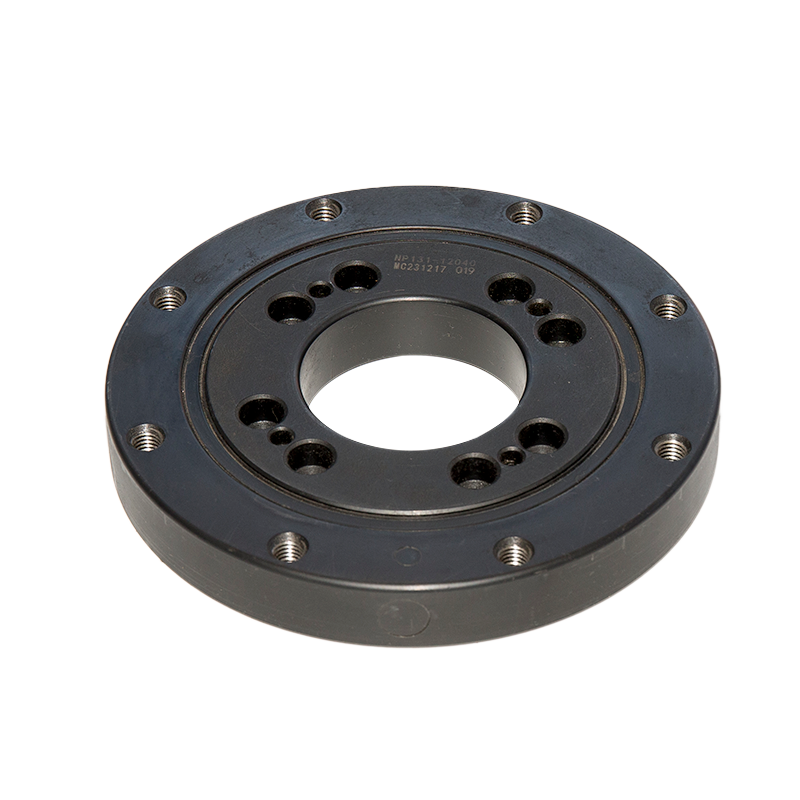What testing methods are used to evaluate the performance and durability of single row cross-roller slewing bearings?
 2025.02.01
2025.02.01
 Industry news
Industry news
To evaluate the performance and durability of single row cross-roller slewing bearings, various testing methods are employed. These methods assess different aspects of the bearing’s functionality, such as load capacity, wear resistance, accuracy, and longevity. Here are some of the key testing methods used:
1. Load Capacity Testing:
Static Load Test: This test is used to determine the bearing's ability to withstand static loads without experiencing permanent deformation. The bearing is subjected to a specified axial, radial, and moment load, and the deformation is measured. This ensures the bearing can handle expected loads in real-world applications without failure.
Dynamic Load Test: The bearing is subjected to dynamic or alternating loads that mimic real operating conditions. This test evaluates how well the bearing can handle repetitive loading without degrading in performance, simulating conditions like those in cranes, wind turbines, or heavy machinery.
2. Fatigue Testing:
Rolling Fatigue Test: This test assesses the bearing’s resistance to rolling contact fatigue (RCF), which occurs when repeated loading causes surface damage to the raceways and rollers. The bearing is subjected to continuous, cyclic loading, and the number of cycles it can endure before failure is measured. This is critical for estimating the bearing's operational lifespan under constant use.
Test with Varying Load Conditions: In this test, the bearing is subjected to fluctuating loads (both axial and radial) to simulate real-life dynamic conditions. The objective is to determine how the bearing withstands varying loads over time and how these conditions impact its durability.
3. Wear and Friction Testing:
Wear Test: The bearing is subjected to continuous operation to simulate wear under normal loading conditions. The test measures the wear rate of the rollers and races over time, helping to assess the bearing’s ability to maintain performance under prolonged use.
Friction Test: The frictional forces generated by the bearing during operation are measured. This test helps evaluate the bearing’s efficiency, as higher friction may indicate excessive wear or poor lubrication, which can affect the bearing’s longevity and energy consumption.
4. Sealing and Contamination Testing:
Seal Integrity Test: This test evaluates the effectiveness of the bearing seals in preventing contamination (e.g., dust, moisture) from entering the bearing while retaining lubrication. Seal integrity is crucial for maintaining the bearing’s performance in harsh environments, such as outdoor or industrial applications.
Ingress Protection (IP) Testing: This test assesses the bearing’s resistance to dirt, dust, and water ingress. It simulates real-life exposure to environmental conditions, ensuring that the bearing can perform reliably even in challenging conditions.

5. Lubrication and Heat Testing:
Lubrication Performance Test: This test assesses how well the lubrication system works under various operating conditions. The bearing is tested with different lubricants to determine the optimal type and amount for smooth operation. It also measures the effectiveness of the lubrication in reducing friction and wear.
Temperature Rise Test: Bearings are often subjected to elevated temperatures to test their performance under high-temperature conditions. This is particularly relevant for bearings that will operate in extreme environments where temperature fluctuations can affect both the lubrication and the material properties of the bearing.
6. Rotation Accuracy and Runout Testing:
Rotation Accuracy Test: The bearing’s precision is tested by measuring the deviation in the rotation of the outer ring or inner ring during operation. This test evaluates how well the bearing maintains rotational accuracy under both light and heavy loads, ensuring that it can perform in applications requiring high positional precision.
Runout Test: This test evaluates the radial runout (deviation from the true circular motion) of the bearing’s raceway and rollers. Excessive runout can affect the bearing’s performance, especially in high-precision applications like robotics and medical equipment.
7. Vibration and Noise Testing:
Vibration Test: Bearings are subjected to vibration measurements to determine how they respond to dynamic loading conditions. Excessive vibration may indicate poor alignment, excessive clearance, or wear, which could reduce the bearing’s operational life and stability.
Noise Test: This test measures the amount of noise generated by the bearing during operation. High levels of noise can be an indicator of internal defects, misalignment, or poor lubrication, which could impact performance and user satisfaction.
8. Environmental and Durability Testing:
Corrosion Resistance Test: Bearings are exposed to corrosive environments (e.g., saltwater or chemicals) to assess how well the materials hold up against corrosion. This test is essential for applications in harsh environments like marine or chemical industries.
High-Altitude and Low-Temperature Test: These tests simulate extreme environmental conditions to ensure the bearing can function under low temperatures or high altitudes, where lubrication and material properties may be affected.
9. Endurance Testing:
Life Cycle Test: The bearing undergoes continuous rotation for extended periods while subjected to loads and environmental conditions to simulate its lifespan. This helps manufacturers estimate the service life of the bearing and identify potential failure points in the design.
Service Life Prediction: Based on the results of endurance tests, manufacturers can predict the expected service life of the bearing under specific operating conditions, which is vital for maintenance planning and reliability assessment.
10. Installation and Alignment Testing:
Assembly and Alignment Check: Proper installation and alignment are critical for optimal performance. Testing methods ensure that the bearing can be correctly assembled and aligned without affecting its performance or causing undue stress on the components.












